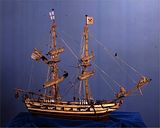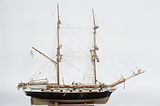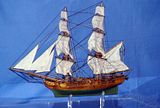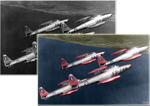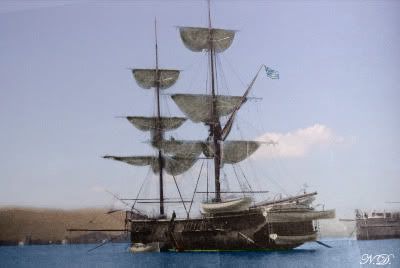 Provided by Hydriot Anastasios Tsamados, the Brig "Aris" participated in several naval operations during the Greek War of Independence.
Provided by Hydriot Anastasios Tsamados, the Brig "Aris" participated in several naval operations during the Greek War of Independence. Aris gained fame for successfully breaking the Egyptian Blockade of Navarino in 1825. At the time, a Greek garrison was quartered at the island of Sphacteria, which controlled the entrance to Navarino's natural harbour. Ibrahim Pasha of Egypt, tasked by the Sultan to suppress the Greek revolt, needed to take the island. When the combined Turkish-Egyptian fleet started bombarding Sphacteria and disembarking its 3,000 troops, the six Greek brigs stationed there were taken by complete surprise. Most of their captains were on land, along with part of their crews, manning the island's defences. Five of the brigs managed to sail before the enemy fleet sealed off the bay, and following a brief skirmish were able to
 escape. "Athina" (not to be confused with Aris's post-war name, which was also "Athina") sailed without her captain, Nikolaos Votsis, and narrowly escaped. The crew of Aris, however, still waited for their captain, Tsamados, who was defending heroically on land although already shot in the leg and fighting on his knees. During the Battle of Sphacteria, 350 of the 800 defenders were killed. When they found out that Tsamados was knocked down and killed, Athina's captain, Votsis, took over as commander, with Dimitrios Sachtouris, the commander of the Navarino fortress, as first mate. Also present on the ship was the Secretary of State, Aleksandros Mavrokordatos, who was sent to the ship for safety.
escape. "Athina" (not to be confused with Aris's post-war name, which was also "Athina") sailed without her captain, Nikolaos Votsis, and narrowly escaped. The crew of Aris, however, still waited for their captain, Tsamados, who was defending heroically on land although already shot in the leg and fighting on his knees. During the Battle of Sphacteria, 350 of the 800 defenders were killed. When they found out that Tsamados was knocked down and killed, Athina's captain, Votsis, took over as commander, with Dimitrios Sachtouris, the commander of the Navarino fortress, as first mate. Also present on the ship was the Secretary of State, Aleksandros Mavrokordatos, who was sent to the ship for safety.  Displaying superb seamanship, Aris set sail through the midst of the Egyptian fleet, being attacked from all sides and exchanging fire for over four hours with several of the 32 enemy ships. At one point, five Egyptian ships tried to ram it. With exceptional display of gunnery, Aris sank one and drove away the other four. Badly damaged, Aris exited the bay. Casualties among the crew were two dead and six wounded. It was time for the icon of the Virgin Mary to be brought up on deck by the sailors.
Displaying superb seamanship, Aris set sail through the midst of the Egyptian fleet, being attacked from all sides and exchanging fire for over four hours with several of the 32 enemy ships. At one point, five Egyptian ships tried to ram it. With exceptional display of gunnery, Aris sank one and drove away the other four. Badly damaged, Aris exited the bay. Casualties among the crew were two dead and six wounded. It was time for the icon of the Virgin Mary to be brought up on deck by the sailors.What followed next is unclear. According to one version, Aris was then attacked by an enemy frigate that tried to ram it, but changed course at the last moment when they heard Votsis ordering his sailors to set fire to their own powder magazine. According to another version, Aris was under full sail when obstructed by two frigates, which she avoided by demonstrating superb seamanship and causing them some damage with her guns. The exit of Aris amidst the 32 enemy ships is depicted in a masterpiece by Volanakis.

Aris was preserved until 1921,
 100 years after the War of Independence, when due to the country's financial difficulties it was sunk near the Naval Base of Salamina. Many had objected and had insisted on the preservation of Aris as a historical ship, but all that is left today is its figurehead at the National Historical Museum in Athens, and surprisingly (and unknown to most people) one of its masts at the Naval Base of Salamina. The mast was actually used for several decades as a mast for signalling purposes, slowly decaying. Its significance must have been realised recently, as it has been replaced and repaired and presumably is preserved somewhere inside the base.
100 years after the War of Independence, when due to the country's financial difficulties it was sunk near the Naval Base of Salamina. Many had objected and had insisted on the preservation of Aris as a historical ship, but all that is left today is its figurehead at the National Historical Museum in Athens, and surprisingly (and unknown to most people) one of its masts at the Naval Base of Salamina. The mast was actually used for several decades as a mast for signalling purposes, slowly decaying. Its significance must have been realised recently, as it has been replaced and repaired and presumably is preserved somewhere inside the base.Operational History
1807 - Built in Venice as a merchant ship.
1819 - Hydriot Anastasios Tsamados buys the ship
1821 - Aris is armed with 16 cannon and 82 crew and is included in the Hydriot Squadron, with with she participates in almost all naval operations and battles in the Aegean, the Peloponnesian Coast and the Corinthian Gulf. 26 Apr. 1825 - Successfully breaks Ibrahim Pasha's blockade and escapes to the open sea.
26 Apr. 1825 - Successfully breaks Ibrahim Pasha's blockade and escapes to the open sea.
After the liberation - Purchased by the Greek Government and renamed "Athina".
1863-1865 - Used as a school for Naval Cadets
1882-1885 - Used as a school for lower personnel
1879 - Renamed again "Aris".
25 Mar. 1921 - Due to financial difficulties of her upkeep, Aris is sunk by honorary salvoes near the Kyra Islet off Salamina Naval Base, during the celebrations for the 100 years since the War of Independence.
Specifications
Brig "Aris" ("Athina")
Displacement: 350 tons
Propulsion: Sail
Length: 30.5m
Width: 8.8m
Draft: 4.9m
Armament: (As built) 16 x 22-pounder cannon, (later) 2 x 12-pounder cannon and 10 x 24-pounder carronades
Crew: 82
For Gamers and Game designers
Until the arrival of steam ships, Brigs, such as Aris, were particularly popular thanks to their speed and manoeuvrability. Their main weaknesses were the fact that they needed relatively large crew to handle its rigging and that they could not easily sail into the wind.
For Modellers
The following are two models of Aris found in the Hellenic Maritime Museum, Piraeus, and a model by Aristotelis Rallis from www.naftoporos.gr.